K5LAD QSL cards through the ages
QSL cards are a special part of ham radio. They provide confirmation
on contacts made between hams but they also provide a wonderful jab to the memory.
They bring back pleasant (usually) memories of contacts between the ham operators.
The confirmations are used to allow awards and certificates for various awards.
Some hams call those certificates "wallpaper" and they proudly display them on
the walls of their hamshacks.
For me, the following display shows cards I have used since becoming a ham in 1957. Some of the cards were ordered from commercial printers and some were homemade. Often the homemade cards were so prepared because there was no money available for such a purchase, and other times because I had printing facilities available to me.
The 1950s
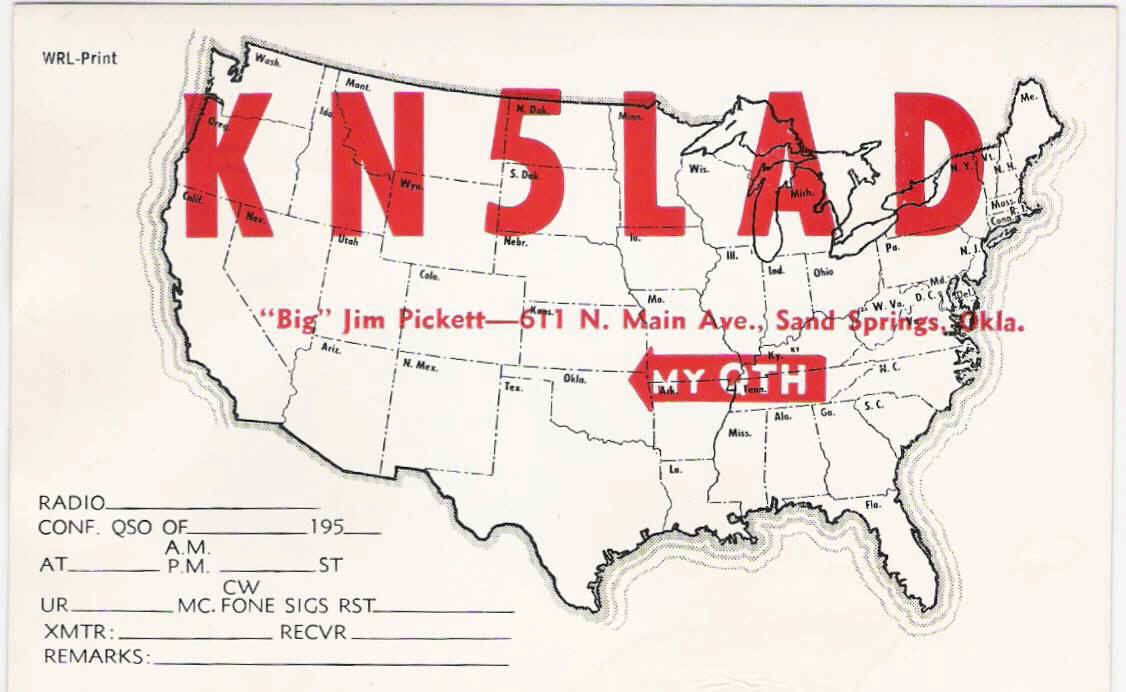
This card really brings back pleasant memories. Old-timers will recognize this card as one printed by World Radio Labs (WRL) in Iowa. They were low cost cards and displayed that new Novice call plus showed (nearly) where my QTH (location) was on the map. This one was a card given to a friend like a QSO card so it is not filled in. He gave it to me in recent years and is the only one I still have.
The blank space above is for my Walter Ashe QSL card. Unfortunately, I don't have a copy of it but old-timers will be able to visualize that card in their mind. The Walter Ashe card had my call (KN5LAD) in large bright orange letters but did not have a map. These cards were also available inexpensively from the ham retailer Walter Ashe (long gone) located in the St. Louis area. Any display of QSL cards from the 1950s and 60s will show many of those cards. I wish I could find one of my old cards to add to this collection.
(as of June 5, 2009)
While cleaning up my shack (I guess I ought to do that more often) I found one of my Walter Ashe cards which had never been filled out. I am very happy to be able to make my collection complete. This card is shown here below:
I'll bet more than 90% of the active hams, particularly Novices, licensed during the latter half of the 1950s ordered a batch of the WRL cards and a batch of the Walter Ashe. It was......... well...... just the thing to do.
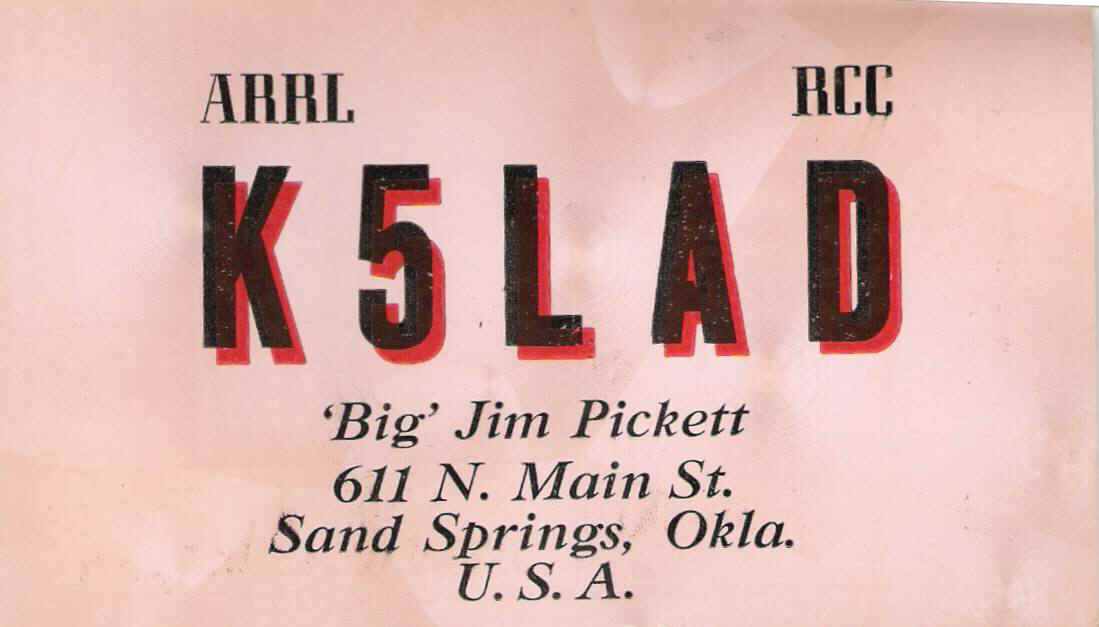
I was so proud of this card above since I printed it myself. Before I started playing with radios and electronics I was interested in printing. I had an old treadle-driven platen printing press in my basement for several years. I even printed some small neighborhood newspapers in my elementary and junior high days. I had a part time job in the local newspaper office (The Sand Springs Leader) and I was able to print these cards on my own time. The paper stock was from trimmed pieces from commercial jobs so it cost me nothing. I don't know how many of these cards I printed and sent out but I know it was a lot. Back then it cost about 3 cents per card to mail a QSL card -- ah, the good ole' days......... where have they gone?
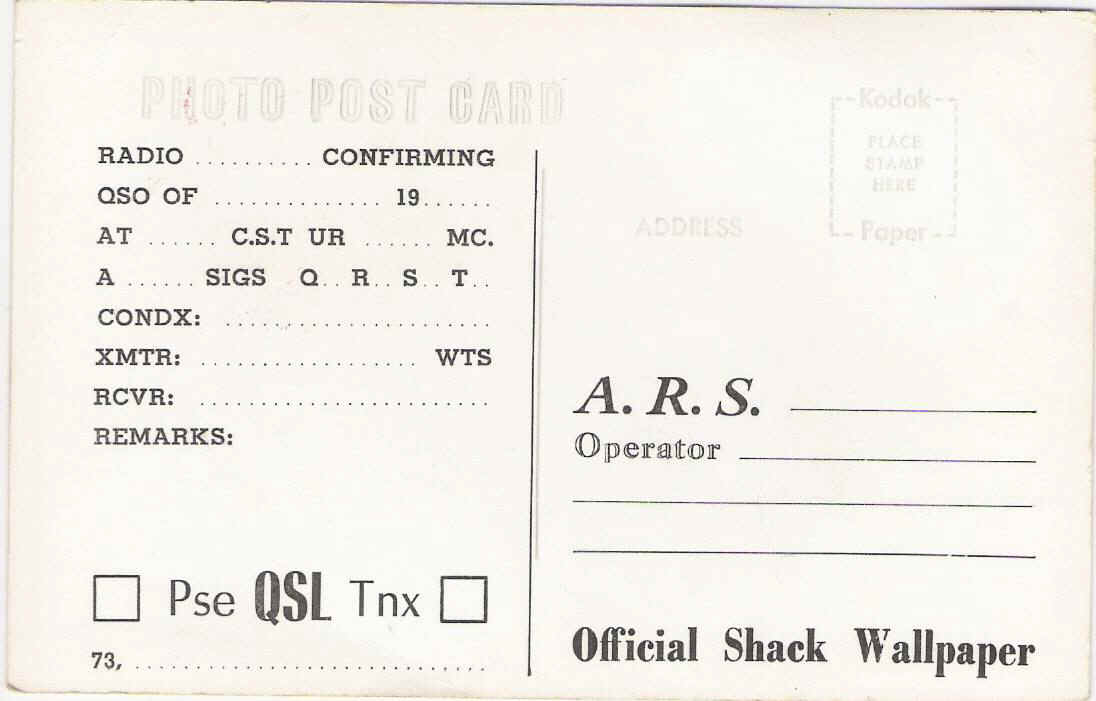
Here's the back side of the pink pearl card.
Gosh, I just had a memory I hadn't thought about in many years. It was not uncommon to write extra comments on a QSL card (on the back) and now I'm almost embarrassed to admit that I sometimes wrote:
Postman, postman, don't be slow.
Make like Elvis -- go man go.
This was in the late 50s in the early Elvis days. I was young and foolish then (for those who know me --- stop that laughing!)
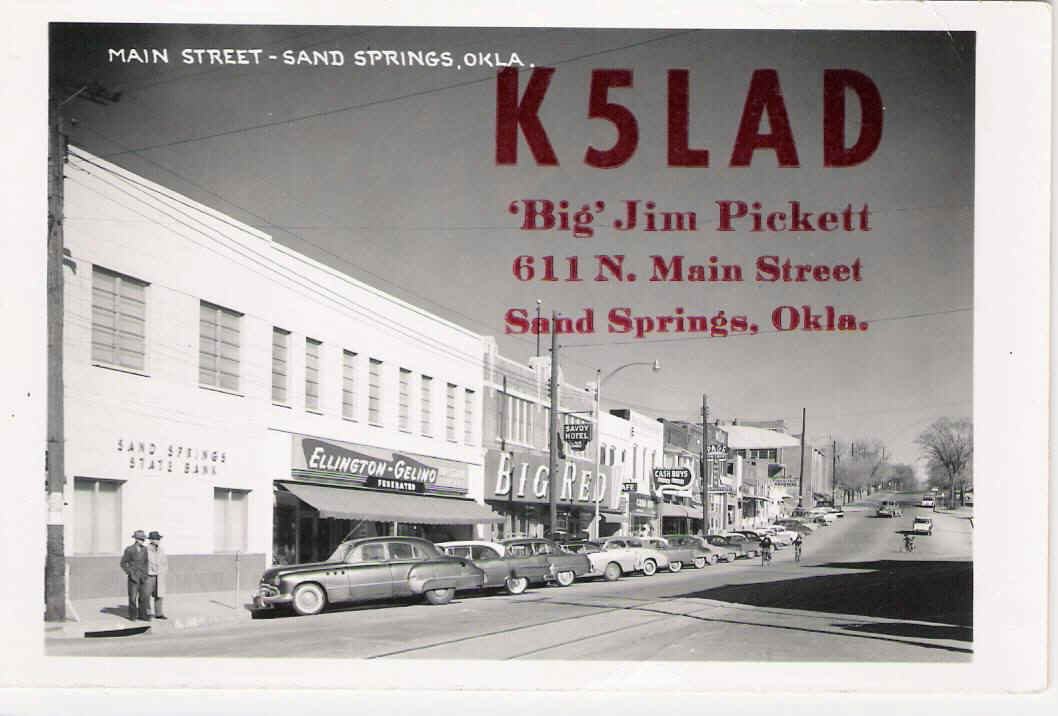
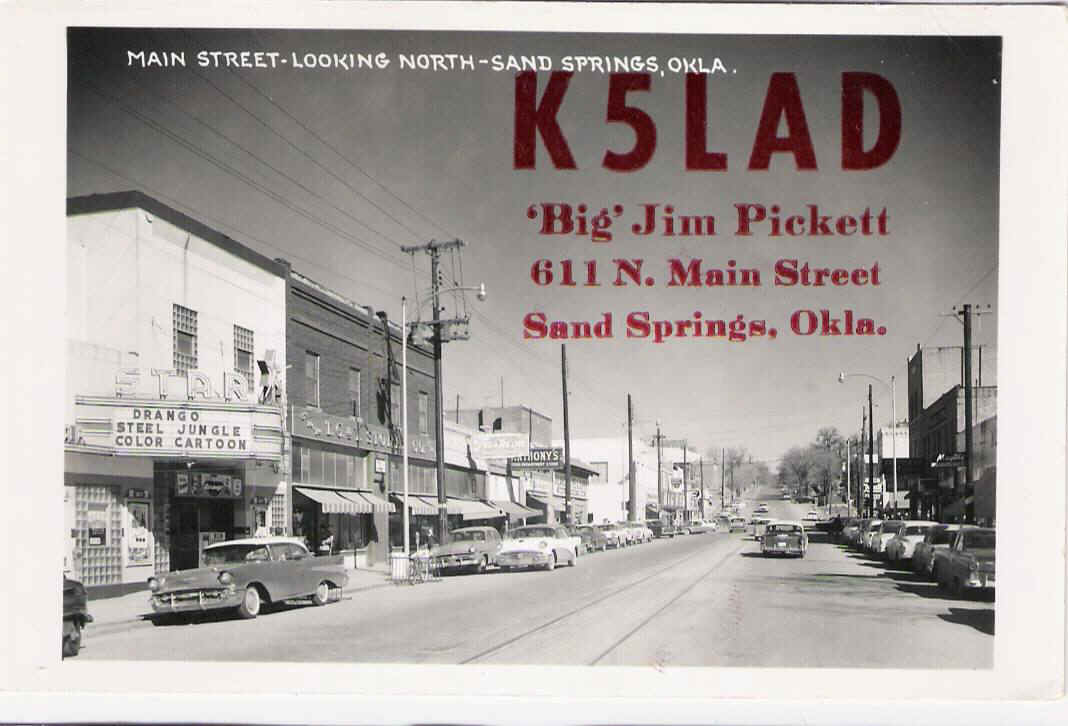
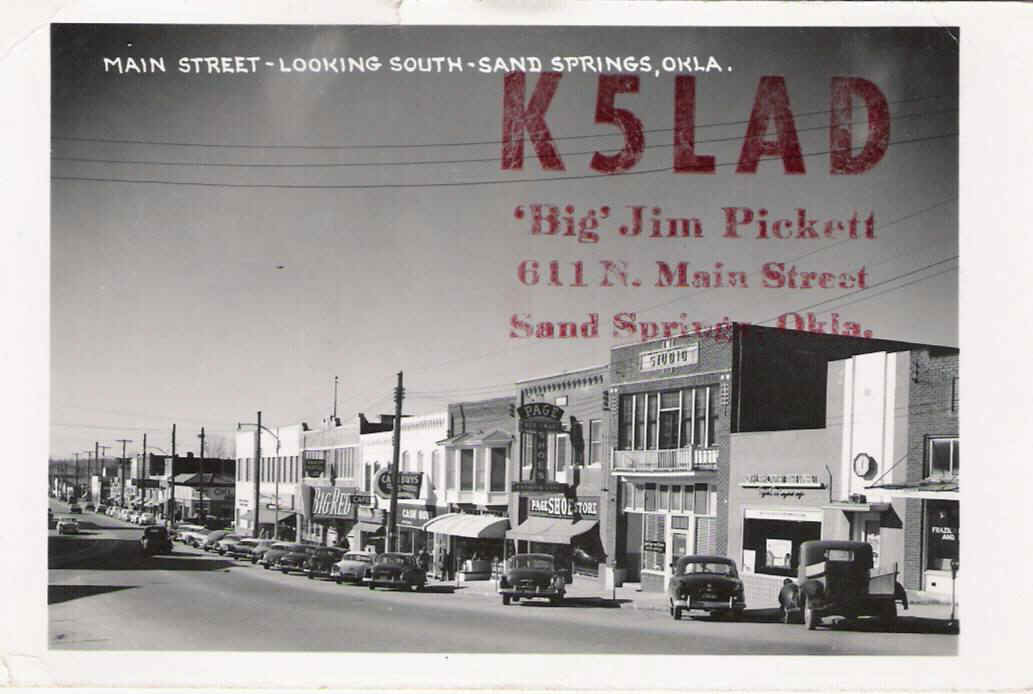
The three cards above were purchased at the local "dime store" (anybody remember them?) It was either the T.G.&Y. or the Ben Franklin store. I think I paid 5 or 10 cents apiece for each of these cards so I only sent them to "special" or DX contacts. Of course at that time DX was probably Wisconsin and for sure, Delaware and Rhode Island. I was still working at the newspaper office and printed the call and name information at that job. Since it was no longer the Novice call, these would have been after 1958 but the automobiles are earlier than this. You'll notice, in a couple of these pictures, that there is a railroad track down the middle of the street. There was a trolley system which transported local folks (including me, often) between Sand Springs and Tulsa. The trolley made its last run in about 1955. It was on these tracks that I learned one of my most valuable lessons:
When you're riding an English bicycle with narrow tires, you should always cross a trolley track perpendicular to it. Failure to do so will give you a nasty spill since the bicycle tire will lock into the groove beside the rail and you will not be able to turn your tire to escape. Gravity will quickly show you how it works.
The 1960s
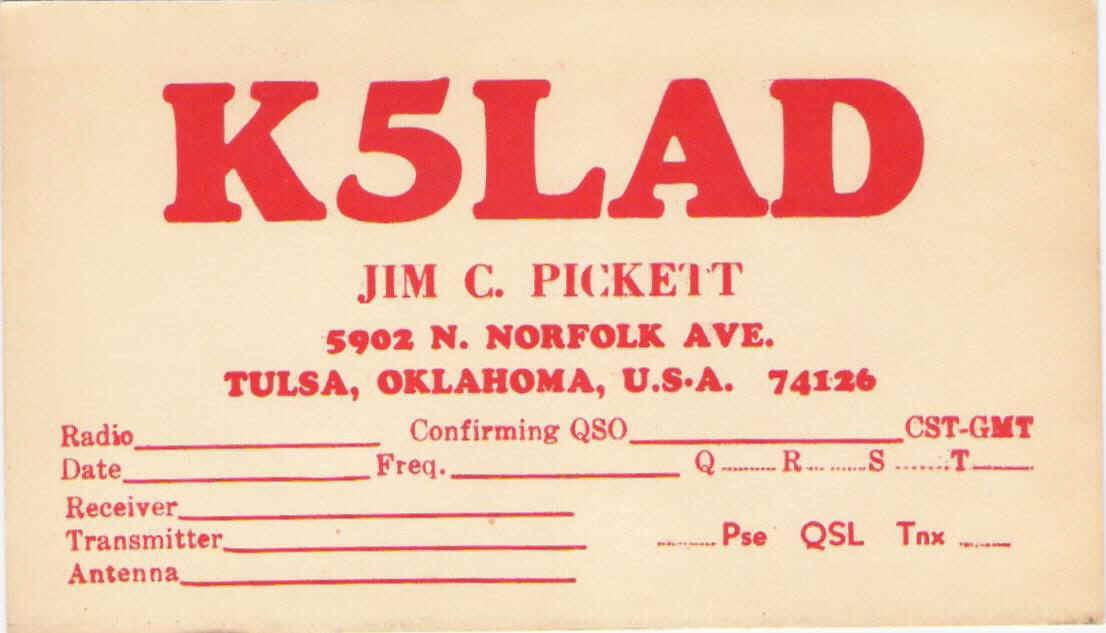
I graduated from college, and got married during the 1960s. These are what might be
called my "lean years" ---- and I don't appreciate that laughter I'm hearing
from those people who know me. The word "lean" refers to a financial
condition. Teaching school did not lend itself to having large amounts of money to
spend on ham equipment and certainly not for QSL cards. The card above was printed
at the junior high where I taught. They had previously had a printshop for the
Industrial Arts Department but the class was no longer available. The printing
equipment was covered up in an empty room and since I had done a good bit of printing in
my earlier days, I got permission to use it. Unfortunately there was no free paper
stock trimmed from jobs done so I had to do with what I could. The card above was
printed on that equipment and was printed on old index cards found (free). Anyone
who received one of these cards from me in those days must have though I was pretty cheap.
Not cheap........... just "po."
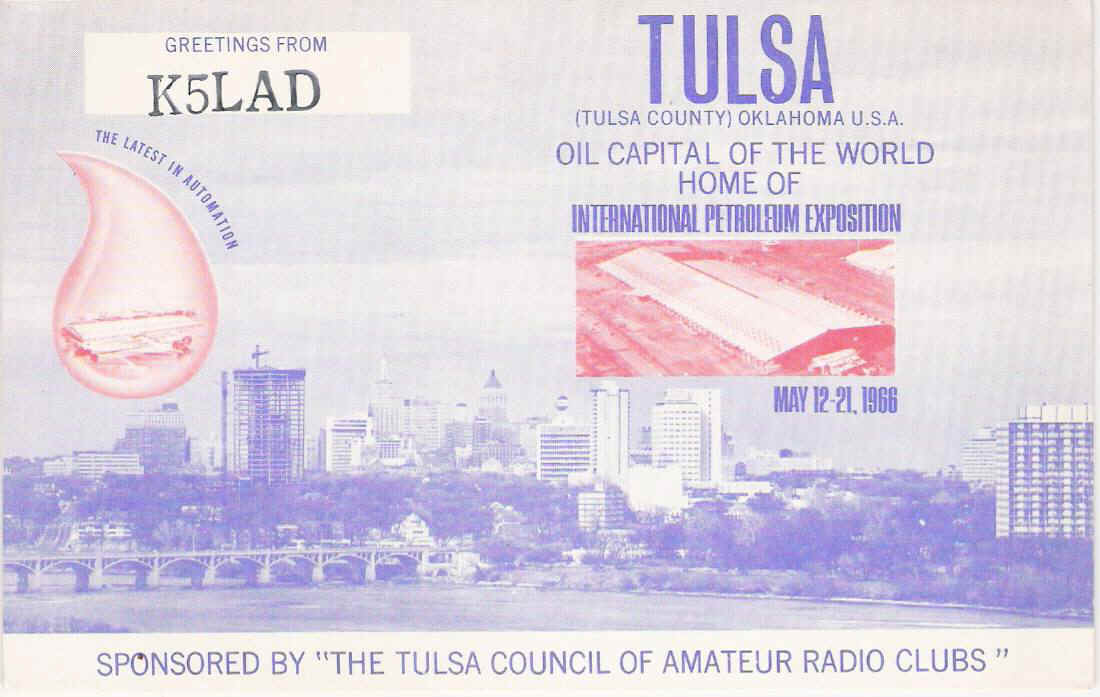
In 1966, the International Petroleum Exposition (IPE) was
held in Tulsa in the newly-constructed IPE Building located on the Fairgrounds property in
the central part of Tulsa. Members of the Electron Benders, as well as members from
several other radio clubs from the area, participated in this activity which provided
amateur radio communications to visitors to the Exposition who came from many countries
around the globe. It was a great introduction, to many of the visitors, to amateur
radio. The QSL cards, like that shown above, were available for sale to hams around
the area to use in advertising this international activity from their home stations.
This was also the QSL used to confirm the hundreds of QSOs made from equipment at
the IPE Building. I used this card for many of the contacts I made during those
weeks during 1966.
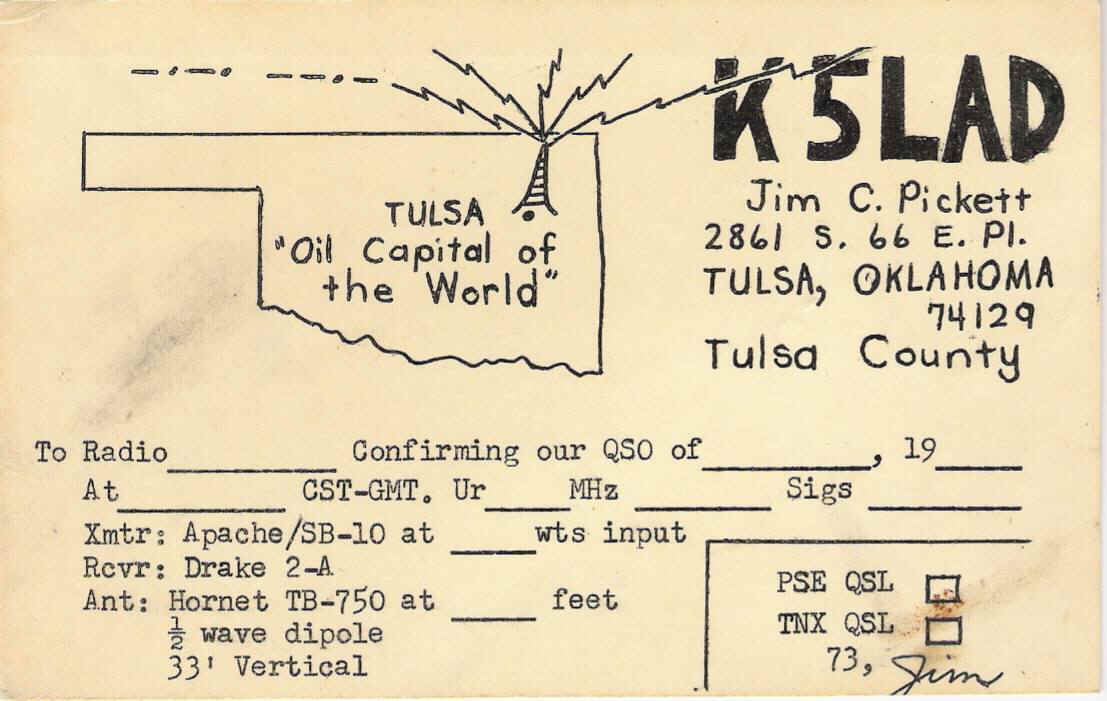
In 1966 we moved to our first house. By now I was teaching and working some extra jobs so things, financially, were not quite so tight. Gloria also won a brand new Suzuki 50 motorcycle by finding a winning token under a Pepsi lid. She let me have it........... that is, she let me have the motorcycle. After riding it for several months (I'm hearing my friends laughing again) while attending summer school in Tahlequah, I traded the motorcycle for a home-brew tower built by a local man. It was made of two 30 foot steel tower pieces which telescoped and overlapped 5 feet. It was nice to have a 55 foot tower, especially one which didn't cost anything. I printed these QSL cards above on an offset press somewhere but I can't remember where I found it. Anyway, I dispensed quite a few of these cards.
The 1970s
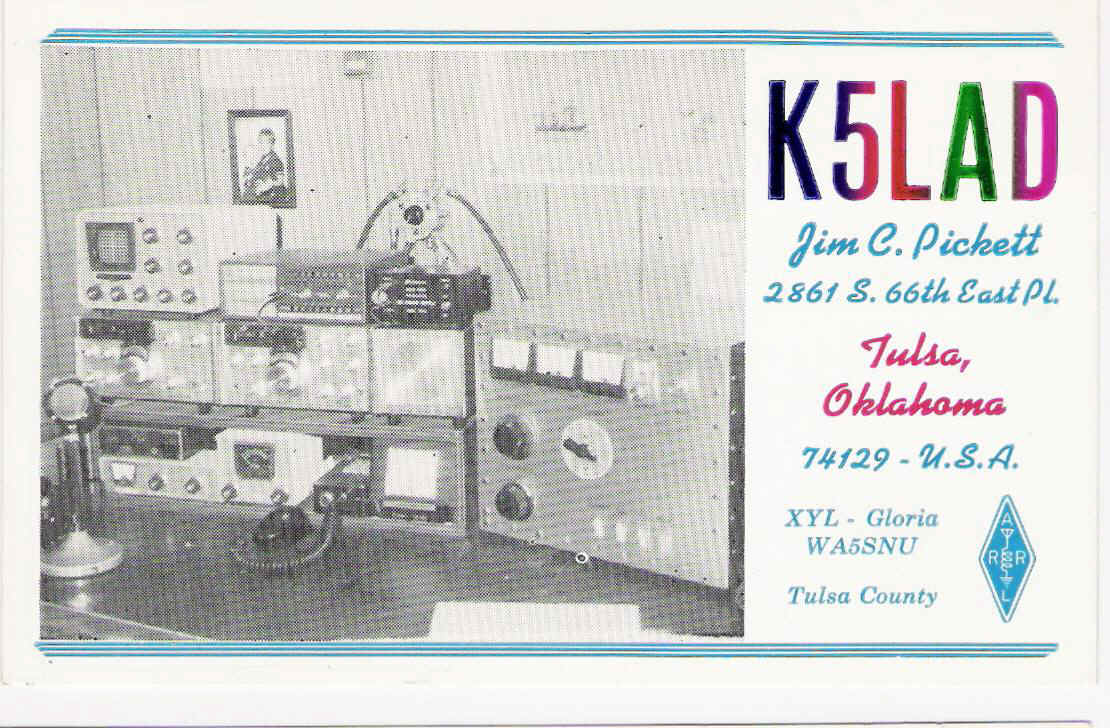
During the 1970s I owned and operated a ham radio store in Broken Arrow, OK (also still teaching full time). A gentleman from Holdenville, OK, and a fellow Army MARS member, was a retired printer and printed QSL cards in his garage. Since customers often asked me where they could get QSL cards, I sent them to Reedy (his name was Reedy Booker - W5ADC, which I always though was an interesting name for a printer) but I didn't make any money from the recommendation. I was just doing it for a friend and a great guy and helped Reedy sell thousands of cards. Several times Reedy would make me up some cards and send them to me as a surprise. On the one above he asked me to shoot a picture of my station for some cards. The equipment was the Kenwood Twins (R-599A/T-599A) which I still own. The amplifier is a 4-1000A which I built in the early 70s and still have and use. Information and additional pictures on this amplifier are located in another area of the web page.
These were nice cards and the first really fancy and store-bought cards I'd had since my Novice days but these were specific to me and were really nice.
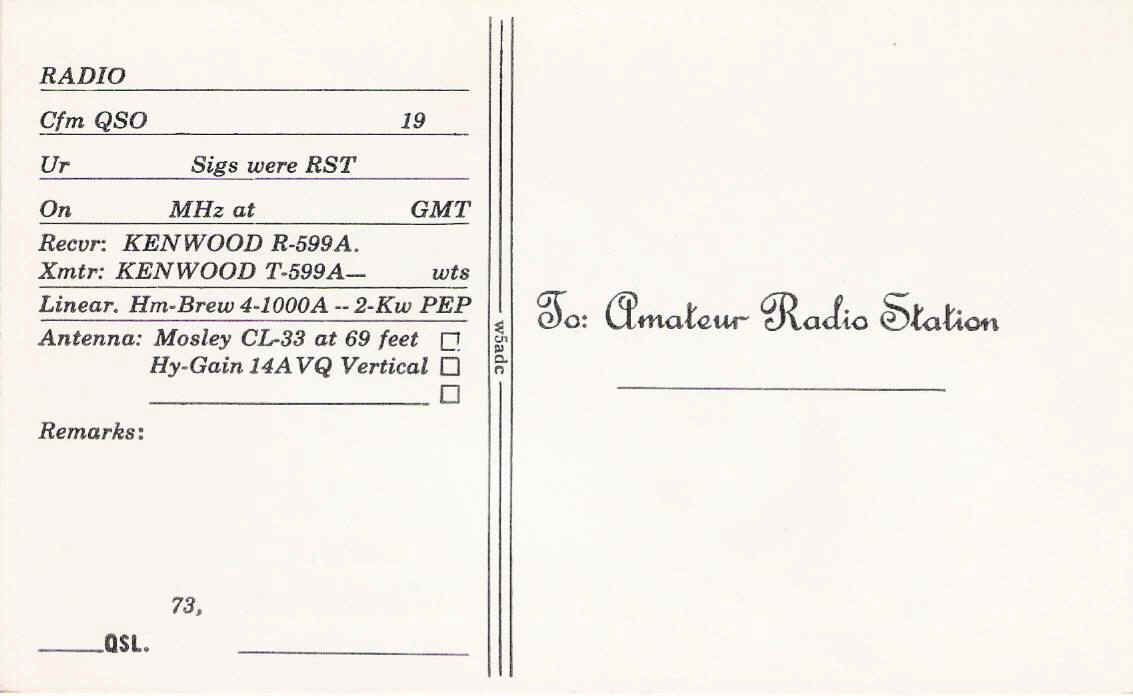
The back of Reedy's cards were similar to this, although this information was for a card used after the mid-70s.
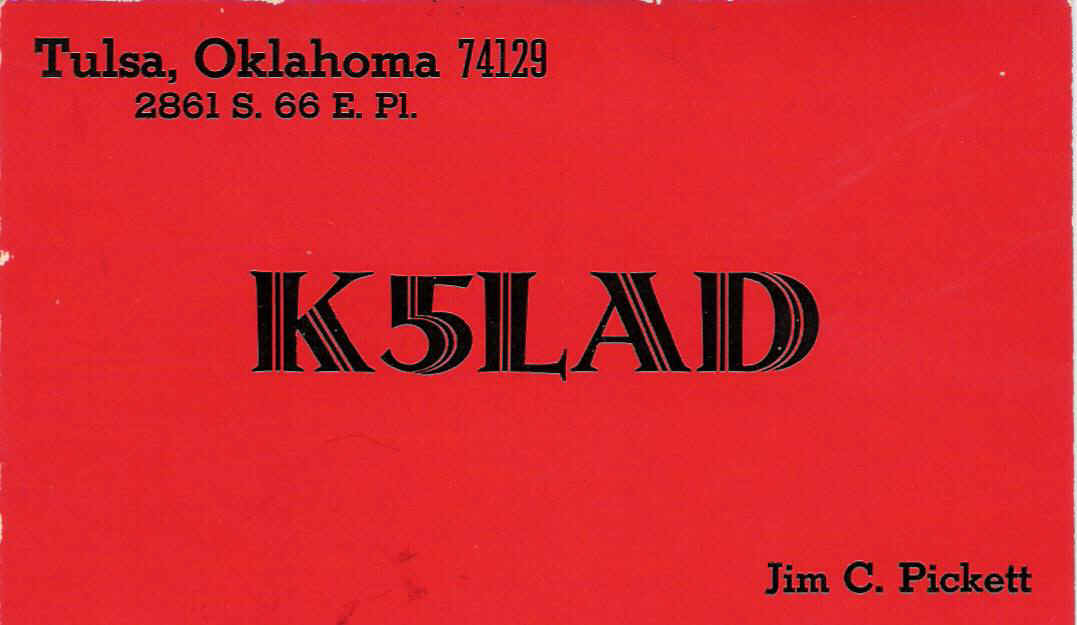
This card was one of a batch which my wife Gloria bought me for a birthday or Christmas surprise. They came from Little Print Shop in Texas. They are the only cards I ever got from Little Print Shop but I sure knew about them and who they were. Back in my early ham days, the Novice license was given to you by another licensed amateur. The examiner would send in the results of your written and your code test and then you waited. Sometimes your examiner would look over the test and tell you if you had passed or failed but they actually were not supposed to do that. They were just to package up the paperwork and send it to the FCC. Back then you had to wait for the results and the wait was usually at least 4 to 6 weeks but sometimes even longer. When the FCC finally sent you your license, it would just arrive in the mail one day and you would know you had passed and also see what your new call was to be. However.............. somehow the Little Print Shop folks were able to get a list of those successful licensees and at least one day and sometimes two days before the FCC document, you would get an envelope of QSL card samples from them. It would be addressed to you with your name and address AND YOUR NEW CALL. Ask any of the old-timers you talk to on the air if they didn't find out what their first call was from Little Print Shop before the FCC told them. At least during the late 50s and perhaps quite a while afterward.
BTW - Even though you received that wonderful news from Little Print Shop, it still was not legal to go on the air with the new call until you had the actual FCC document in hand. I wonder how many Novices jumped the gun? I know I certainly did not as I would have been afraid that the FCC man was right outside my window. I waited....... but I already knew what my new call was, thanks to the L.P.S. guys.
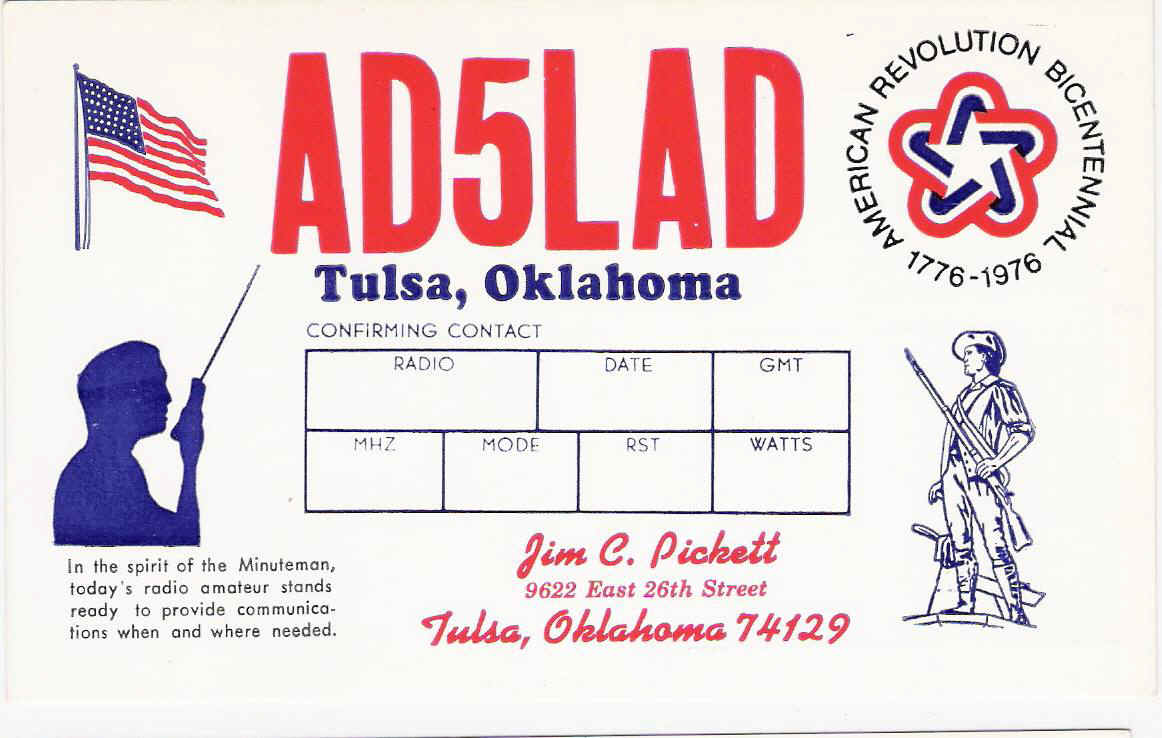
During the year 1976, the U.S.A. was having its bi-centennial celebration and the FCC allowed US stations to sign with a special prefix. I don't remember all of the various prefixes but those with a K were allowed to become AD so I signed and operated during that year as AD5LAD. Reedy didn't want me to be left out so he sent me a big batch of the cards above with that call.
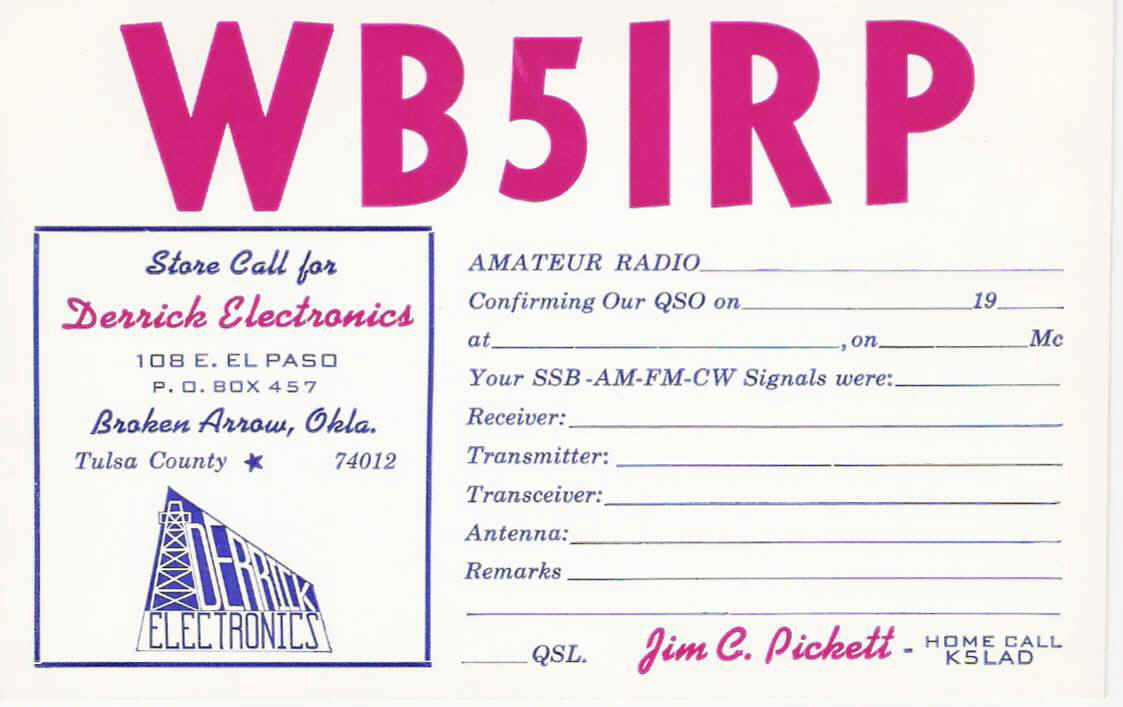
Since we had a ham station set up at the store, we also got a secondary license for that one. The call was WB5IRP which lent itself to several interesting phonetics: I'm Really Pooped, I'm Real Pretty but one of the best came from Adrian "Preacher" Rea - W5DRZ. Preacher was a retired Methodist preacher and he worked for me at the store. The phonetic he liked to use was, "I'm (a) Retired Preacher."
We later got the call, WB5BWT, but I didn't find any cards for that call and I'm not even sure we ever had any.
The 1980s
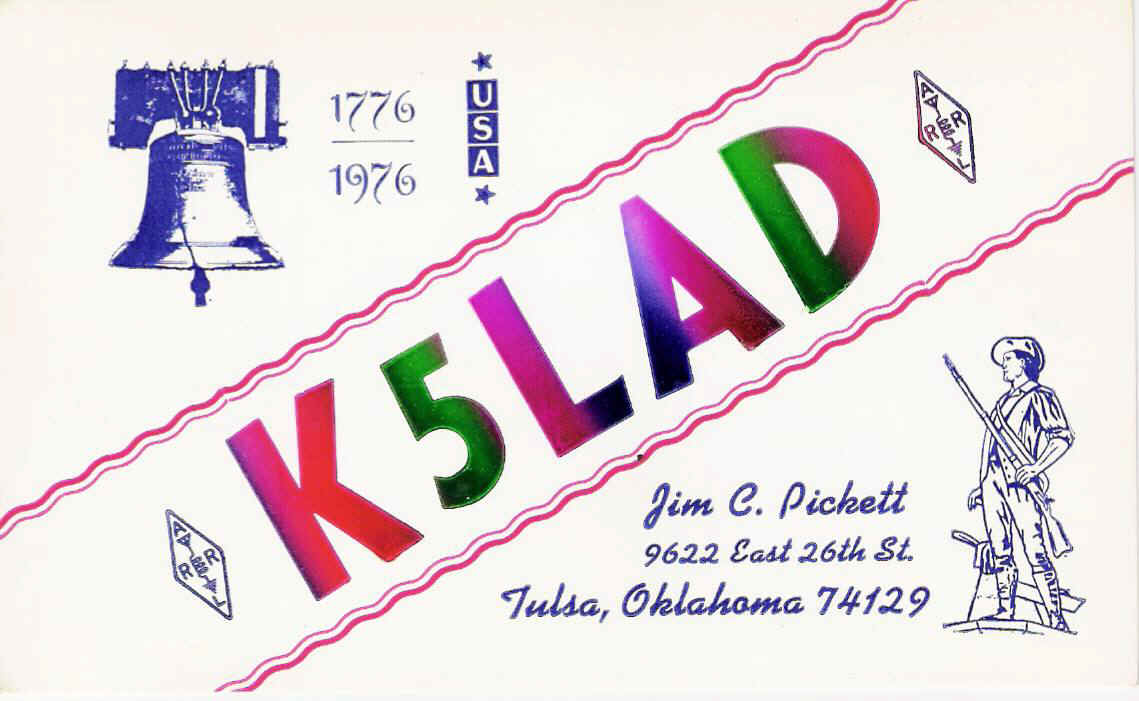
This card from Reedy also was from around the bi-centennial but with my regular call. I used them all through the decade of the 80s. It was sure nice to have commercially printed cards. Now that I could finally afford to have my cards printed, I was getting them for nothing. Life sure takes funny turns sometimes.
The 1990s
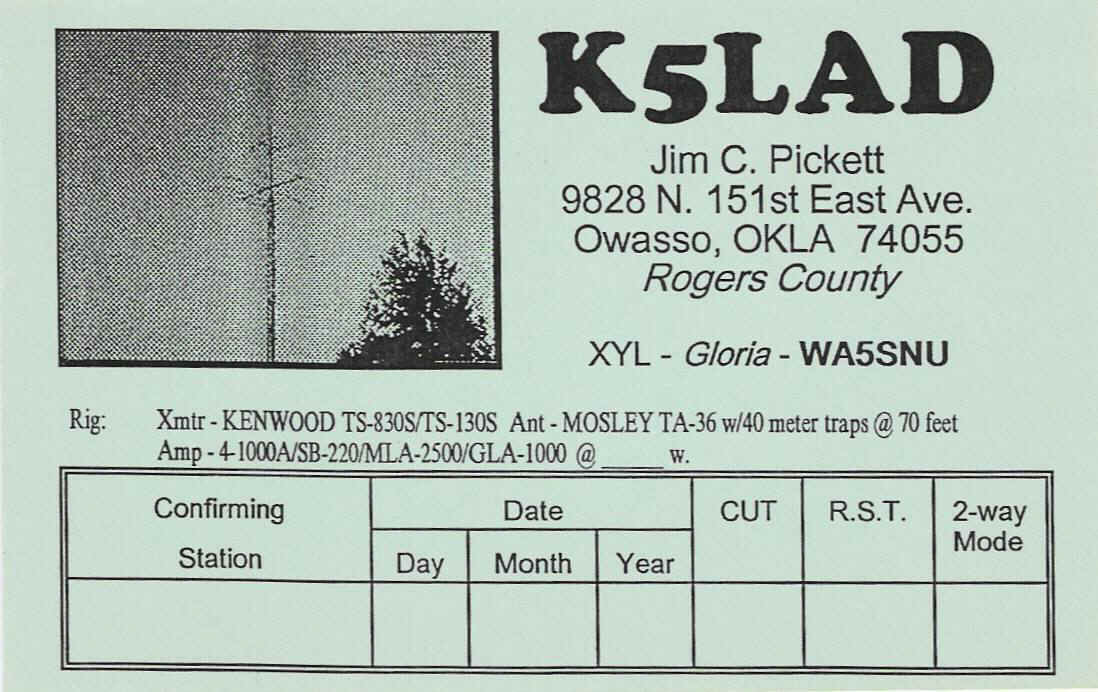
I printed lots of the card above after creating it with WordPerfect on the computer. I was given a good supply of card stock to print them on. Even though this card stock was not the nice shiny glossy kind, I did have a good selection of colors so I gave out hundreds (maybe more) of this card in various colors. The picture was of the tower and antenna set up I had after we moved to Owasso, OK in 1992. At the time I took the picture, digital cameras were not as advanced as they are now so it didn't do justice to the tower and antenna.
The 2000s
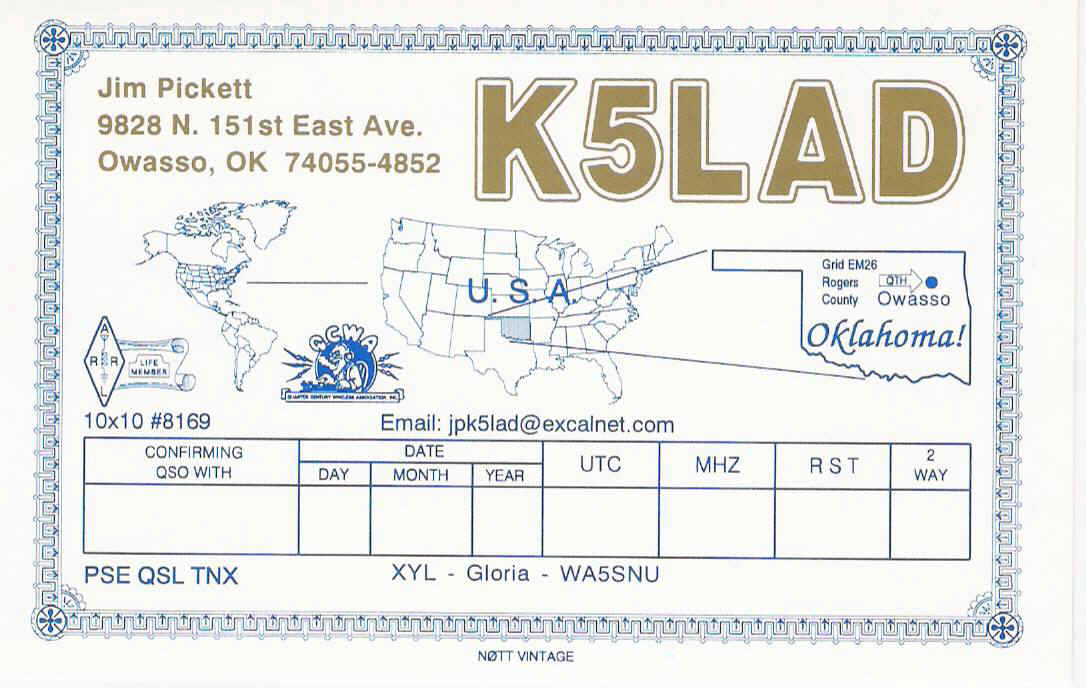
I graduated to the above card as I got even more active at home. Oddly enough, after nearly 50 years I've come back to a card like the first one which has a map which shows where I live. Perhaps this exemplifies the old saying, "What goes around, comes around."
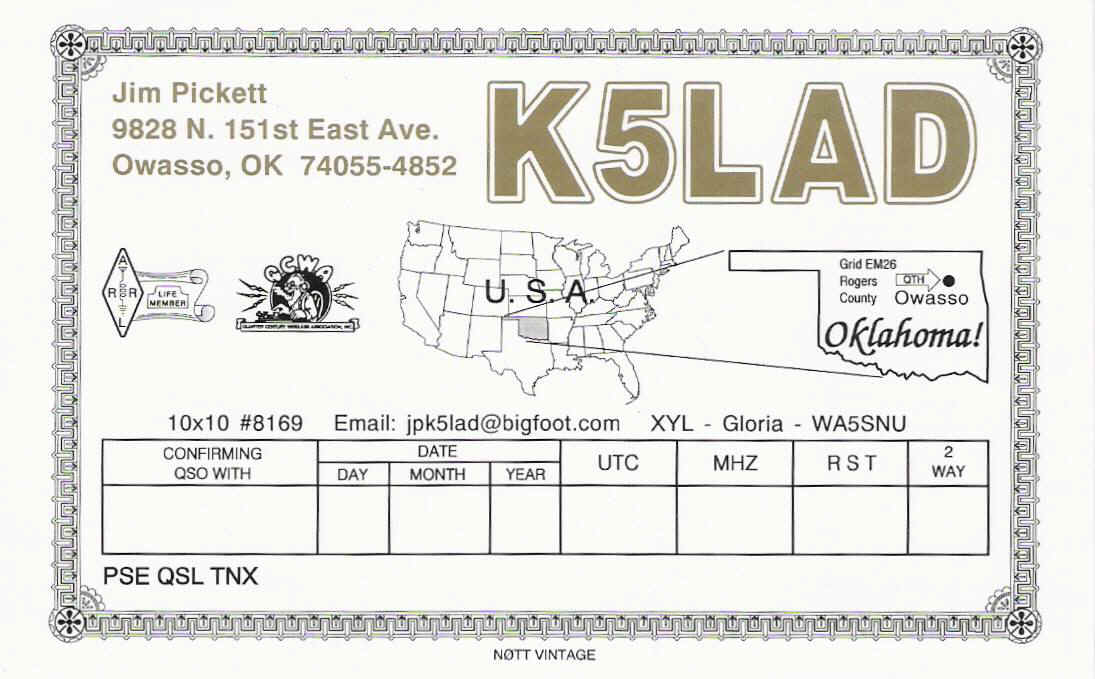
I liked that last card so well that when it came time to re-order, I used the same format but just changed the border from blue to black.
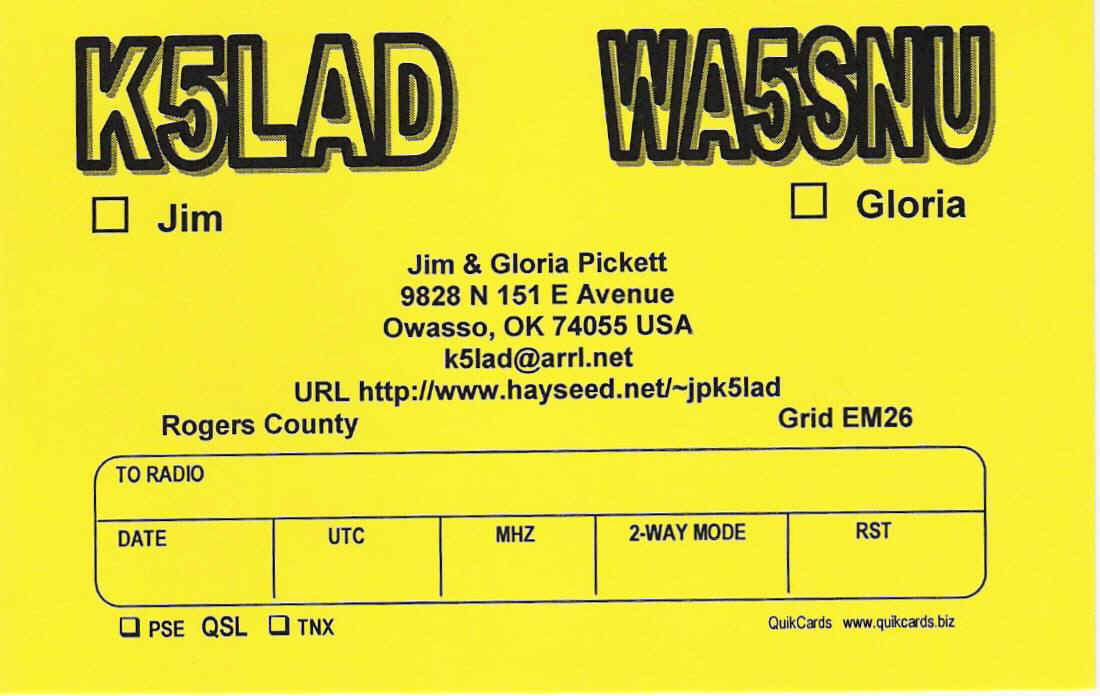
This last card is the most recent and includes calls for both Gloria and myself. The information on it is actually still current.
Update:
In early 2011 I replenished my supply of blank QSL cards to try to catch up with many of the more recent contacts I had made, particularly in contests. Since the new "in look" for QSL cards is the full-color card, I'd hoped to get one of these for my next group of cards ordered. Many hams like to include a nice color picture of their station and/or themselves but I knew that would never work for me. It would take too long to clean up my shack to a "picture perfect" setting and I KNEW I didn't want a picture of myself on a card so I went a different route. I'd looked at quite a few samples from numerous QSL printers but I chose the cards from Randy - KB3IFH. I liked his work and the prices were reasonable so I communicated with him.
I sent Randy some suggestions for what I wanted and he returned samples of what he could do in .pdf format. I made some additional changes and he quickly sent revised files to incorporate the changes and the order was placed.
The front of the card is a picture of the call-letter license tags issued by Oklahoma. The state had made the format design change for most of the regular Oklahoma tags during the previous year and in late 2010, they sent along the call letter tags to match the new format.
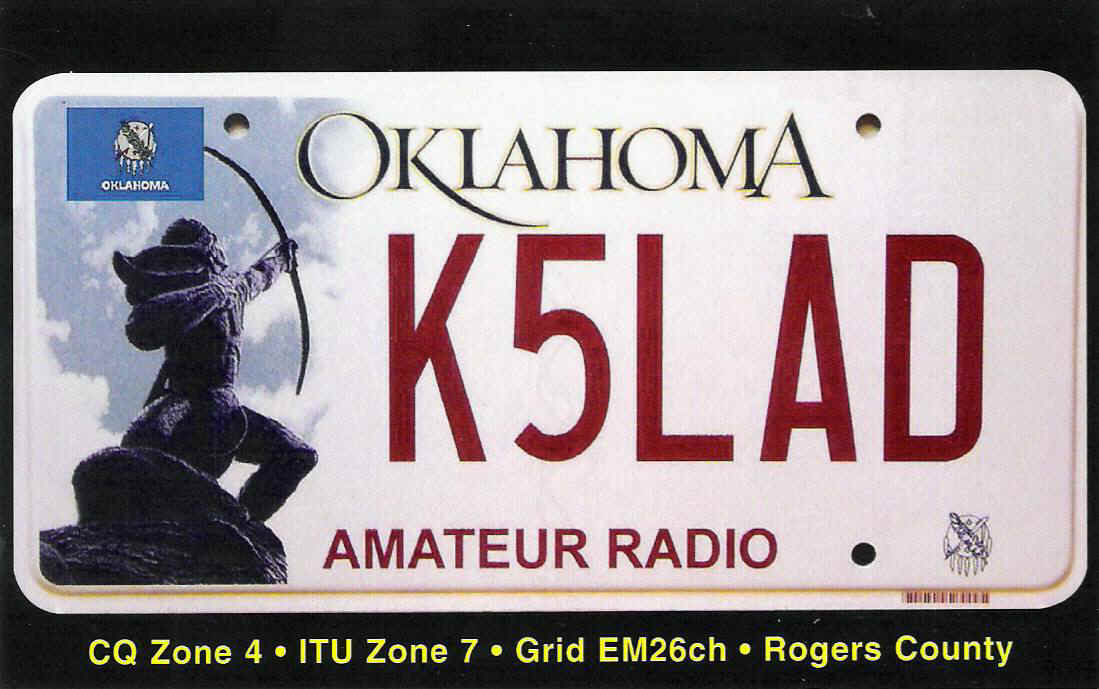
For the back side of the card I wanted most of the information and the space for contact with a single station but since I like to work contests and DXpeditions, I often have multiple contacts, on different bands and modes, with the same station and call. I use LogPrint, along with Logger32, to print my QSL card labels and the 2" x 4" label allows me quite a few contacts on that same label. I had sufficient space left on the card's back side to stick this printed 2" x 4" label and not cover any other card information like had happened with previous cards. The back of the card looks like this:
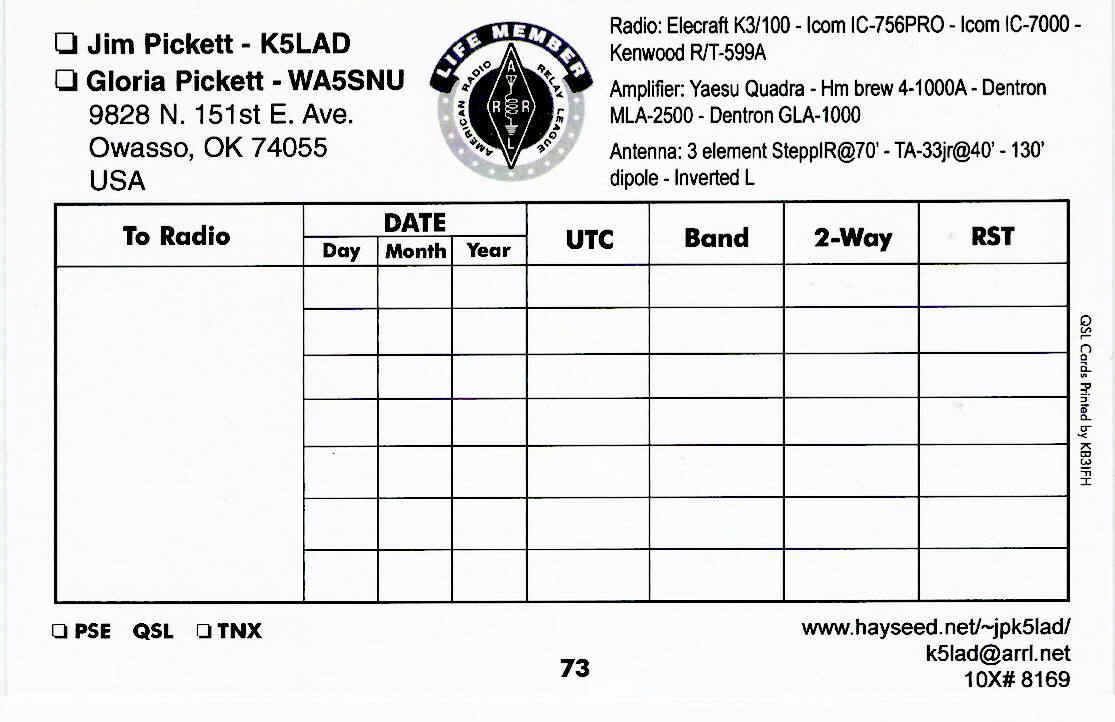
This has worked out well and my first batch of these cards sent to the ARRL Outgoing QSL Bureau weighed just over 4 pounds. I didn't even count how many cards were in the box. I needed and wanted to send them all on their way so I just paid the requested amount and now I'm awaiting all the answers.
It can be noted that many hams have quite a collection of their old QSL cards which bear many different calls. They have changed calls as they've moved from one call district to another plus some have requested a vanity call or calls and have piled up more calls. Personally, I just liked the call I started with and I've pretty much stayed in the same geographical area so I guess I haven't worn out the first call I received. I guess as I get older and older it might be some comfort to me that I'll always be a lad.
Jim - K5LAD
December 08, 2006
=============================================================
Updated 03/20/11 08:02 PM
Page visited 2021 times
Back to Memory Menu